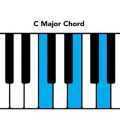The piano is a unique instrument in the way that it’s as dynamic and powerful as it is easy to learn and play, especially with the amount of easy piano songs that have been written over the years. In 1700, a harpsichord was adapted by an Italian instrument maker into a piano by adding small hammers that struck strings instead of plucking them. The new addition made the new instrument sound monumentally different. What changed? A piano’s dynamic range is one of the most powerful of any modern instrument as opposed to the harpsichord which features no dynamic range.  The keys of a piano’s keyboard are designed to perfectly fit a person’s hand, making the instrument easy to learn.
The keys of a piano’s keyboard are designed to perfectly fit a person’s hand, making the instrument easy to learn.
But what songs should a beginning piano student play to get started? Great question! We’ve rounded up some easy piano songs to help you get started on this incredible instrument. Some are modern popular songs and other ones are older well-known pieces, but all of them are easy piano songs to play. To learn these songs you’ll need to be familiar with how to build chords on the piano. Check out our articles on music theory and beginning jazz piano if you need help with that.
“Two Weeks” by Grizzly Bear
The Brooklyn-based band Grizzly Bear earned widespread acclaim with their 2006 album Yellow House, and 11 years later the group’s position as the world’s most well-known indie band remains intact. “Two Weeks” is a piano-driven track that has one foot firmly planted in lush 60’s pop music and one firm planted in the catchy pop music of the present. The piano part in this song is played in short staccato stabs, and your biggest challenge in learning this song will be to learn how to play chord transitions quickly and without mistakes. We recommend playing all of these easy piano songs slowly and to the steady beat of a metronome before you attempt to play along with the recorded versions of the songs.
[Intro]
F Am C
(these are all barre chords, and the F is high)
[Verse]
F Am C
Save up all the days
F Am C
A routine relays
F Am
Just like yesterday
C F Am C
I told you I would stay
[Chorus]
Bb F C
Would you always
Bb F C
Maybe sometimes
Bb F C
Make it easy
Bb F C
Take your time
[Instrumental]
F Am C
[Verse]
F Am C
Think of all the ways
F Am C
Momentary phase
F Am C
Just like yesterday
F Am C
I told you I would stay
F Am C
Every time you try
F Am C
Quarter half the mile
F Am C
Just like yesterday
F Am C
I told you I would stay
[Chorus]
Bb F C
Would you always
Bb F C
Maybe sometimes
Bb F C
Make it easy
Bb F C
Take your time
“The Scientist” by Coldplay
Coldplay’s “The Scientist” is a simple, yet affecting, modern love song that showcases a powerful yet subdued character of the piano’s sound. Released in 2002, this epic love ballad features slow transitions of simple piano chords played under a haunting vocal melody. Easy piano songs like this prove that great music doesn’t have to be difficult to play. The B/C chords instruct the musician to place a B note in the bass of a C chord. On its own, this chord sounds strange and dissonant, but in the context of the song it fits in perfectly.
[Intro]
Am F C B/C x2
[Verse I]
Am F C
Come up to meet you, tell you I’m sorry
B/C Am
You don’t know how lovely you are
F C
I had to find you, tell you I need you
B/C Am
Tell you I set you apart
F C
Tell me your secrets, and ask me your questions
B/C Am
Oh let’s go back to the start
F C
Running in circles, coming up tails
B/C
Heads on a science apart
[Chorus]
F C
Nobody said it was easy
B/C
It’s such a shame for us to part
F C
Nobody said it was easy
B/C D
No one ever said that it would be this hard
A
Oh take me back to the start
[Interlude]
Am F C C Am F C B/C
[Verse II]
Am F C
I was just guessing at numbers and figures
C Am
Pulling the puzzles apart
F C
Questions of science, science and progress
C Am
Do not speak as loud as my heart
F C
Tell me you love me, come back and haunt me
C B/C Am
Oh and I rush to the start
F C
Running in circles, chasing our tails
C B/C
Coming back as we are
[Chorus]
F C
Nobody said it was easy
B/C
It’s such a shame for us to part
F C
Nobody said it was easy
B/C D
No one ever said that it would be this hard
A
Oh take me back to the start
[Solo]
Am F C C
Am F C B/C
[Ending]
Ah-Oooohh…
Am F C C
Ah-Oooohh…
Am F C C
Ah-Oooohh…
Am F C B/C
Ah-Oooohh…
Am F C
“Oh Darling” by The Beatles
When people think of music written by The Beatles, they often picture complex, virtuosic pieces of music carefully crafted and composed by master songwriters. While members of The Beatles certainly were master songwriters, they often wrote very simple music that are easy piano songs. “Oh Darling” is a terrific song that beginner piano students won’t have a difficult time learning. This song plays homage to American blues music, and the piano features a short staccato treatment with simple chord transitions played over a medium-paced 12/8 rhythm. The E+ chord you see at the beginning of the song is an E Augmented chord (E-G#-B#). Augmented chords tend to sound odd and even a bit jarring. This song is a blast to learn and will most likely get stuck in your head for the next few months. Enjoy!
[Verse]
E+ A E
Oh___ darling please believe me
F#m D
I’ll never do you no harm
Bm7 E7
Be-lieve me when I tell you
Bm7 E7 A
I’ll never do you no harm
[Instrumental]
A – D – A – E
[Verse]
E A E
Oh___ darling if you leave me
F#m D
I’ll never make it alone
Bm7 E7
Believe me when I beg you
Bm7 A
Don’t ever leave me alone
[Instrumental]
A – D – A – E
[Chorus]
A7 D F7
When you told me you didn’t need me anymore
A
Well you know I nearly broke down and cried
B7
When you told me you didn’t need me anymore
E7 F7(5) E7 E+
Well you know I nearly fell down and died___
[Verse]
E+ A E
Oh darling if you leave me
F#m D
I’ll never make it alone
Bm7 E7
Believe me when I tell you
Bm7 E7 A
I’ll never do you no harm
[Interlude]
A – D – A – A7
(Spoken) Believe me, darling
[Chorus]
A7 D F7
When you told me you didn’t need me anymore
A
Well you know I nearly broke down and cried
B7
When you told me you didn’t need me anymore
E7 F7(5) E7 E+
Well you know I nearly fell down and died___
[Verse]
E+ A E
Oh darling please believe me
F#m D
I’ll never let you down
(spoken) oh believe me darling
Bm7 E7
Believe me when I tell you
Bm7 E7 A
I’ll never do you no harm
[Outro]
A – D – A – Bb7 – A7
“Some Things Last a Long Time” by Daniel Johnston
Next on our list of easy piano songs is Daniel Johnston’s “Some Things Last a Long Time”. Daniel Johnston is a songwriter hailing from the Austin, Texas lo-fi scene of the early 90’s. “Some Things Last a Long Time” is a simple yet haunting song that makes use of simple rhythms, repetitive chord transitions, and a looseness you’d usually find in a jazz piece. Johnston has famously battled Bipolar disorder throughout his 30-year songwriting career, and his simple songs manage to be playful, manic and often profound. Johnston’s loose rhythmic interpretation of this song suits his version, but we recommend mastering a straightforward rhythmic approach to this song before moving on to something more loose.
[Intro]
Am, C, Dm, F, G
Am C Dm F
your picture
Am C Dm F
is still
Am C Dm F
on my wall
Am C Dm F
on my wall
Am C Dm F
the colors
Am C Dm F
are bright
Am C Dm F
bright
Am C Dm F
as ever
Am C Dm F
the red is strong
Am C Dm F
the blue is pure
G F C
some things last a long time
G F C
some things last a long time
-(the rest of the song follows the same progression)-
your picture
is still
on my wall
on my wall
I think
about you
often
often
I can’t forget all the things we did
some things last a long time
some things last a long time
it’s funny
but it’s true
and it’s true
but it’s not funny
time comes and goes
all the while
I still think of you
some things last a long time
your picture
is still
on my wall
on my wall
the colors
are bright
bright
as ever
the things that we did
I can’t forget
some things last a lifetime
some things last a lifetime
“Werewolves of London” by Warren Zevon
This song might sound difficult to play at first, but the repetitive nature of the piano part makes it one of pop music’s great easy piano songs. Released in 1978, this song boasts a catchy atmosphere influenced by American blues music. The song’s verses and choruses are identical, so you’ll only need to learn and memorize only one piano part for the entire song.
[Intro]
D D C C G G G G 4x
D C G
I saw a werewolf with a Chinese menu in his hand
D C G
Walking through the streets of Soho in the rain
D C G
He was looking for a place called Lee Ho Fook’s
D C G
Going to get a big dish of beef chow mein
D C G
Ah-ooooo, werewolves of London
D C G
Ah-ooooo
D C G
Ah-ooooo, werewolves of London
D C G
Ah-ooooo
D C G
If you hear him howling around your kitchen door
D C G
You better not let him in
D C G
Little old lady got mutilated late last night
D C G
Werewolves of London again
D C G
Ah-ooooo, werewolves of London
D C G
Ah-ooooo
D C G
Ah-ooooo, werewolves of London
D C G
Ah-ooooo
D D C C G G G G 4x
D C G
He’s the hairy-handed gent who ran amok in Kent
D C G
Lately he’s been overheard in Mayfair
D C G
You better stay away from him
D C G
He’ll rip your lungs out, Jim
D C G
Ha, I’d like to meet his tailor
D C G
Ah-ooooo, werewolves of London
D C G
Ah-ooooo
D C G
Ah-ooooo, werewolves of London
D C G
Ah-ooooo
D C G
Well, I saw Lon Chaney walking with the Queen
D C G
Doing the werewolves of London
D C G
I saw Lon Chaney Jr. walking with the Queen
D C G
Doing the werewolves of London
D C G
I saw a werewolf drinking a piña colada at Trader Vic’s
D C G
His hair was perfect
D C G
Ah-ooooo, werewolves of London
Draw blood
D C G
Ah-ooooo
D C G
Ah-ooooo, werewolves of London
D C G
Ah-ooooo
These easy piano songs will be a breeze to learn, but only if you take the time to hone in your playing technique and practice. It’s a smart idea to nail down piano basics like scales, warmups, and the knowledge of how to build basic chords before you attempt to learn any of these songs. Check out the Musika Lessons blog for help with how to get started with piano basics.







